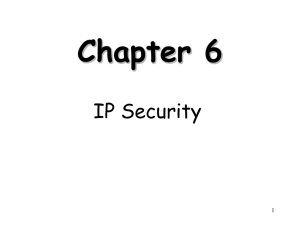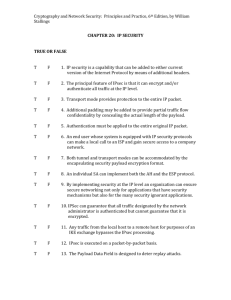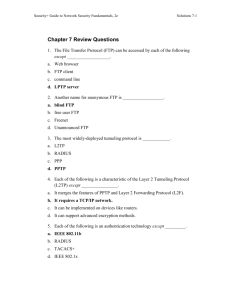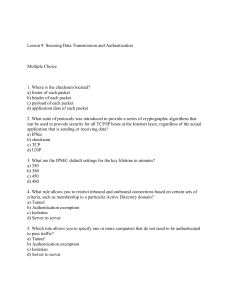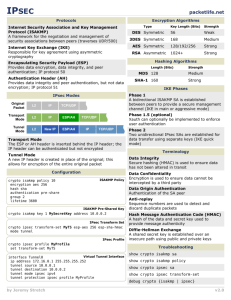Problem Set 3
advertisement
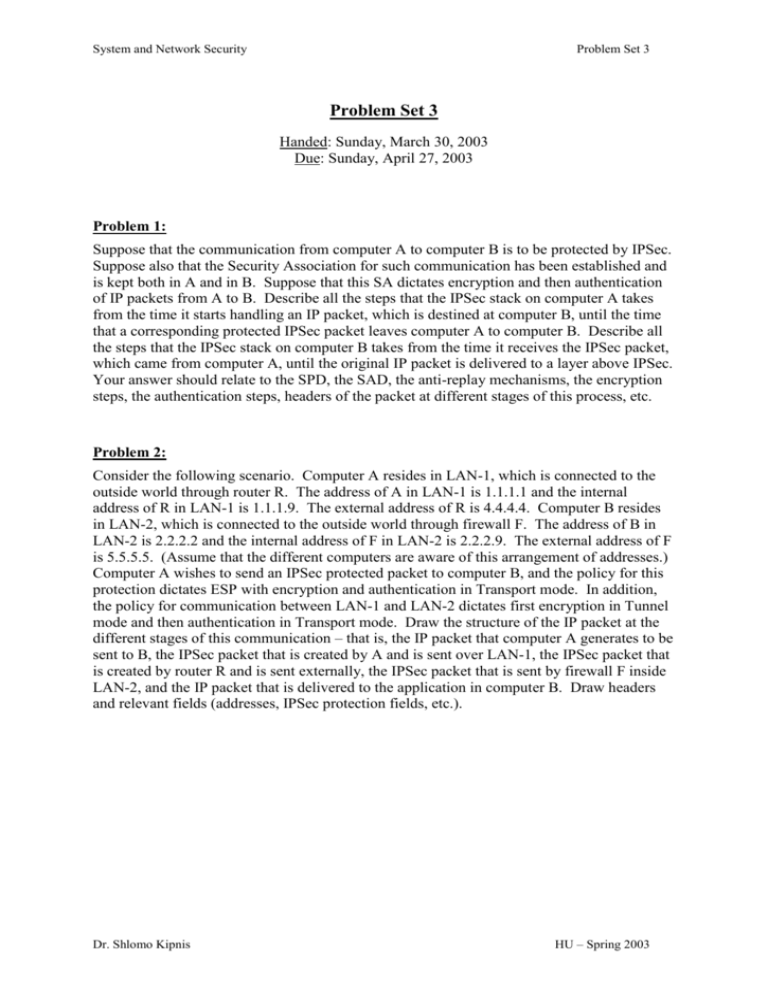
System and Network Security Problem Set 3 Problem Set 3 Handed: Sunday, March 30, 2003 Due: Sunday, April 27, 2003 Problem 1: Suppose that the communication from computer A to computer B is to be protected by IPSec. Suppose also that the Security Association for such communication has been established and is kept both in A and in B. Suppose that this SA dictates encryption and then authentication of IP packets from A to B. Describe all the steps that the IPSec stack on computer A takes from the time it starts handling an IP packet, which is destined at computer B, until the time that a corresponding protected IPSec packet leaves computer A to computer B. Describe all the steps that the IPSec stack on computer B takes from the time it receives the IPSec packet, which came from computer A, until the original IP packet is delivered to a layer above IPSec. Your answer should relate to the SPD, the SAD, the anti-replay mechanisms, the encryption steps, the authentication steps, headers of the packet at different stages of this process, etc. Problem 2: Consider the following scenario. Computer A resides in LAN-1, which is connected to the outside world through router R. The address of A in LAN-1 is 1.1.1.1 and the internal address of R in LAN-1 is 1.1.1.9. The external address of R is 4.4.4.4. Computer B resides in LAN-2, which is connected to the outside world through firewall F. The address of B in LAN-2 is 2.2.2.2 and the internal address of F in LAN-2 is 2.2.2.9. The external address of F is 5.5.5.5. (Assume that the different computers are aware of this arrangement of addresses.) Computer A wishes to send an IPSec protected packet to computer B, and the policy for this protection dictates ESP with encryption and authentication in Transport mode. In addition, the policy for communication between LAN-1 and LAN-2 dictates first encryption in Tunnel mode and then authentication in Transport mode. Draw the structure of the IP packet at the different stages of this communication – that is, the IP packet that computer A generates to be sent to B, the IPSec packet that is created by A and is sent over LAN-1, the IPSec packet that is created by router R and is sent externally, the IPSec packet that is sent by firewall F inside LAN-2, and the IP packet that is delivered to the application in computer B. Draw headers and relevant fields (addresses, IPSec protection fields, etc.). Dr. Shlomo Kipnis HU – Spring 2003 System and Network Security Problem Set 3 Problem 3: Consider the following threats to web security, and describe how each is countered by a particular feature of SSL. (a) Brute Force Cryptanalytic Attack – An exhaustive search of the key space for a conventional encryption algorithm. (b) Known Plaintext Dictionary Attack – Many messages will contain predictable plaintext, such as the HTTP GET command. An attacker constructs a dictionary containing every possible encryption of the known-plaintext message. When an encrypted message is intercepted, the attacker takes the portion containing the encrypted known plaintext and looks up the ciphertext in the dictionary. The ciphertext should match against an entry that was encrypted with the same secret key. If there are several matches, each of these can be tried against the full ciphertext to determine the right one. This attack is especially effective against small key size (e.g., 40-bit keys). (c) Replay Attack – Earlier SSL handshake messages are replayed. (d) Man-in-the-Middle Attack – An attacker interposes during key exchange, acting as the client to the server and as the server to the client. (e) Password Sniffing – Passwords in HTTP or other application traffic are eavesdropped. (f) IP Spoofing – User forges IP addresses to fool a host into accepting bogus data. (g) IP Hijacking – An active and authenticated connection between two hosts is disrupted and the attacker takes the place of one of the hosts. (h) SYN Flooding: An attacker sends TCP SYN messages to request a connection but does not respond to the final message to establish the connection fully. The attacked TCP module typically leaves the “half-open connection” around for a few minutes. Repeated SYN messages can clog the attacked TCP module. Problem 4: The SSL Handshake Protocol has many modes of operation (simple handshake with server authentication only, client authentication with certificate, ephemeral-RSA authentication by server, fixed DH/DSS mutual authentication, ephemeral DH mutual authentication, session resumption, and more). For each mode, specify which random values need to be generated by the client and by the server, and specify which public-key operations need to be performed by the client and by the server. Dr. Shlomo Kipnis HU – Spring 2003

